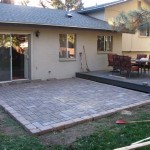Designing A Patio For Your Homes
A patio is an extension of your home that can provide a comfortable and inviting space for relaxation, entertaining, or simply enjoying the outdoors. Designing a patio that complements your home and meets your needs requires careful planning and consideration of various factors. This article will guide you through the process of designing a patio for your home, addressing key aspects such as purpose, location, materials, and design elements.
Defining the Purpose of Your Patio
The first step in designing a patio is to determine its intended use. This will help shape the design and features you incorporate. Consider the activities you envision enjoying on your patio. Will it be a space for dining, lounging, cooking, or a combination of these? Do you envision hosting large gatherings or simply enjoying quiet evenings with your family?
For example, a patio designed for dining would likely require a spacious table and chairs, while a patio for relaxation might prioritize comfortable seating, shade, and perhaps a fire pit. Understanding the primary purpose of your patio will guide your decisions regarding layout, furniture selection, and overall aesthetic.
Choosing the Right Location
The location of your patio is crucial for its functionality and enjoyment. Consider the following factors:
- Sunlight and Shade: Evaluate the amount of sunlight and shade your chosen location receives throughout the day. Consider whether you prefer a sunny patio for tanning or a shaded area for escaping the heat.
- Privacy: Assess the level of privacy offered by the chosen location. Consider factors like nearby buildings, traffic, or pedestrian pathways. You may want to incorporate privacy screens or hedges for a more intimate setting.
- Access: Ensure easy access to and from the patio. Consider proximity to your home, existing walkways, and potential for future landscaping.
- Views: If possible, position the patio to take advantage of scenic views, such as a garden, a forest, or a nearby lake.
Selecting Materials for Your Patio
The choice of materials for your patio floor, furniture, and other elements will significantly impact its overall appearance, durability, and maintenance requirements. Here are some popular patio materials:
- Concrete: Concrete is a durable and cost-effective option that can be finished in various ways to create different aesthetics.
- Stone: Natural stone, such as flagstone or pavers, provides a classic and elegant look. Stone is durable and can withstand harsh weather conditions.
- Wood: Wood decking offers a warm and natural feel. However, it requires regular maintenance to prevent weathering and decay.
- Composite Decking: Composite decking combines wood fibers with plastic, offering durability, low-maintenance, and a wood-like appearance.
- Tile: Tile flooring provides a wide range of design options, including patterns and colors. Choose a tile that is frost-resistant if you live in a cold climate.
Designing the Layout and Features
Once you have determined the purpose, location, and materials for your patio, you can begin designing the layout and incorporating features that enhance its functionality and beauty.
- Layout: Consider the flow of traffic and the placement of furniture. Create distinct zones for different activities, such as a dining area, a seating area, and a grilling area.
- Furniture: Choose patio furniture that complements the style of your home and meets your functional needs. Consider seating arrangements, tables, and storage options.
- Lighting: Adequate lighting is essential for evening use. Consider string lights, lanterns, spotlights, or integrated lighting in the patio floor or furniture.
- Shade: For hot climates, provide shade with umbrellas, pergolas, or a retractable awning.
- Fire Feature: A fire pit or fireplace can add ambiance and warmth to your patio, especially during cooler evenings.
- Privacy Screens: For enhanced privacy, consider adding privacy screens made of wood, metal, or plants.
Adding Finishing Touches
The final touches can transform your patio from functional to exceptional. Consider adding landscaping elements, incorporating water features, or adding decorative accents to enhance the overall aesthetic.
- Landscaping: Plant flowers, shrubs, or trees to create a visually appealing and inviting space.
- Water Features: A small water fountain or pond can create a calming atmosphere and add visual interest.
- Decorative Accents: Add decorative elements like cushions, throws, rugs, and sculptures to personalize your patio and reflect your style.

Best Patio Design Ideas For Your Home Designcafe

10 Tips To Design Outdoor Patio For Your Home

Dk Studio

Attached Covered Patio Ideas For Your Home Richmond American Homes Blog

50 Patio Ideas For The Backyard Of Your Dreams

7 Concrete Patio Design Ideas To Enhance Your Home

Beautiful Backyard Patio Design And Ideas Designcafe

Deck Ideas 40 Ways To Design A Great Backyard Or Patio Sunset

Best Small Outdoor Patio Ideas Forbes Home

Beautiful Backyard Patio Design And Ideas Designcafe
Related Posts








